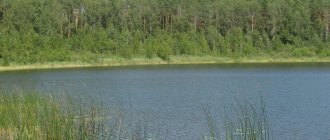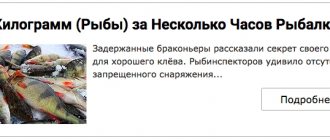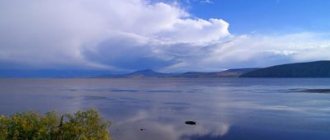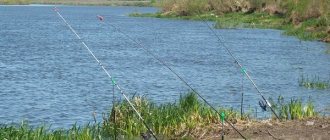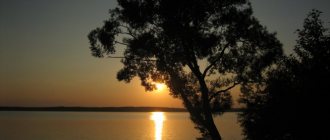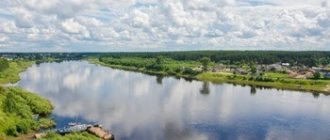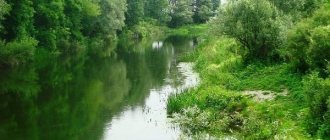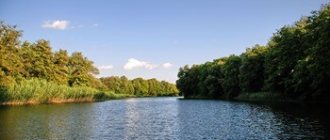Characteristics of the Desna River
The source is located on the Smolensk Upland; it is believed that the river begins in the Golubev Mokh peat bog, seven kilometers from the city of Yelnya. First, the Desna flows through the Bryansk and Smolensk regions in Russia, and then crosses the border and flows through the territory of Ukraine. Within Ukraine, the river flows through the Chernigov, Sumy and Kyiv regions. In its upper reaches, the Desna has low and swampy banks. Below the city of Bryansk, the right bank becomes higher. The Desna river valley becomes wider after the Seima tributary flows into it.
Where the Desna River flows can be seen on the map of Ukraine. It eventually flows into the Dnieper in the northern part of the city of Kyiv. The Desna River is the second most important tributary of the Dnieper.
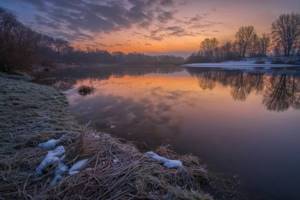
Ice appears on the river from December to April. In the spring there is a large flood; it is during this period that navigation becomes possible in some sections of the river. The river flooded to its maximum in 1931.
Source
The Desna River begins on the Smolensk Upland. Once upon a time, the river took its source from the Golubev Moss peat bog. Nearby there is a village with the same name. But peat extraction was carried out here for a long time, and the natural flow of the river was disrupted. Mining began in 1936, was carried out in the pre-war, war and post-war years, the swamp was drained. It was once very large (650 hectares) and promising (peat reserves of 15 million cubic meters). Now peat extraction is not carried out here, and the swamp is gradually being restored. Lingonberries, cranberries and blueberries grow. Small pines and birches are interspersed with sphagnum and marsh grass. Not far from the swamp there is a concrete slab with the inscription “Source of the Desna River”. The beginning of the river is marked purely symbolically; the stele stands in the middle of the forest. The characteristic features of the Desna as a river become visible only below the village of Prilepy, where several streams merge, the largest being Zhukovka and Gramada.
Description
The Desna is formed by the confluence of the Pakhorka and Butyn rivers near the village of Kalininets. It flows into the Pakhra near the village of Dubrovitsy, near Podolsk[4].
The length is 88 km, the drainage basin area is 717 km²[5]. The main nutrition of the Desna, like most Moscow rivers, comes from melted snow waters: they make up about 60% of the total total flow, the share of rainwater ranges from 12 to 20%. The rest comes from underground springs[6].
The tributaries of the Desna are the Sosenka and Neznaika rivers[7][8].
On the banks of the Desna are the village of Alabino, the cities of Aprelevka and Troitsk[9].
Tributaries
Throughout the entire length of the river (1,130 kilometers), many small water streams flow into it.
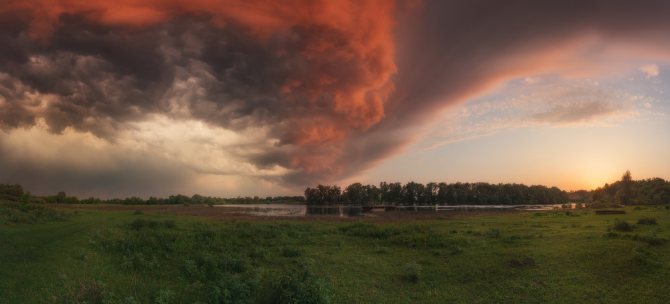
There are 31 tributaries of the Desna River. 18 of them flow from the right side, and 13 from the left. Among the tributaries, the Seim can be distinguished - it is the longest, its length is 717 kilometers. It flows into the Desna on the left side. Then the right tributary - Snov - with a length of 233 kilometers, and the Oster flowing from the left (226 kilometers) stand out. In addition, the Desna is fed with its waters: Ubed (97 km), Belous (58 km), Shostka (57 km), Mena (56 km).
[edit] Notes
- Tourist water encyclopedia. Moscow region. Tributaries of Moscow
- Tourist water encyclopedia. Moscow region. Tributaries of Moscow
- Tourist water encyclopedia. Moscow region. Tributaries of Moscow
- Tourist water encyclopedia. Moscow region. Tributaries of Moscow
- Tourist water encyclopedia. Moscow region. Tributaries of Moscow
- Tourist water encyclopedia. Moscow region. Tributaries of Moscow
- Tourist water encyclopedia. Moscow region. Tributaries of Moscow
Source - ""
Category: Rivers of Russia
Estuary
The Desna River, having passed its path, flows into the large Dnieper River, the fourth longest in Europe. The mouth of the Desna is represented by two branches, one of which is called the Desna. In the upper part it is specially dammed so that the main water flows into only one sleeve. At the confluence of the Desna and the Dnieper, you can see the difference in the color of the water. The waters of the Desna have a light blue tint due to the presence of chalk particles, which the river takes in as it passes through the chalk deposits. The Dnieper has a darker shade.
Transport route
The Desna River had transport significance back in ancient times. It connected Kyiv and its surroundings with the basin of the Don and Oka rivers. The Desna is suitable for navigation to the city of Novgorod-Seversky, which is located 535 kilometers from where the river flows into the Dnieper. Irregular shipping is carried out to the village of Zhukovka, located above Bryansk.

Before the war, the Desna River was navigable even to the city of Bryansk, but due to many factors it is gradually becoming shallower. The reason for this is considered to be global warming, deforestation in the water protection zone and peat extraction in the area of the river's source. In the second half of the 20th century, steamships operated only in the lower reaches from Chernigov to Kyiv. Now at the beginning of the 21st century, cargo shipping is possible only to Chernigov, and then during a period of high water levels. Only small ships can sail higher.
Desnogorsk Reservoir
The Desnogorsk reservoir can be considered the most significant object on the Desna River. It is located in Russia on the territory of the Smolensk region and is a cooling pond for the Smolensk nuclear power plant. Its height above sea level is 193 meters. The dam is located in the city of Desnogorsk. The reservoir has impressive dimensions, its length is 44 kilometers and its width is 3 kilometers. The average depth is 7.6 meters, and the maximum is 22. The reservoir began to fill with water in 1979.
Recently, exotic fish species for Russia have begun to be bred in the reservoir, since the water is warm even in winter. These are representatives living in lakes and rivers of Africa - Mozambican catfish and tilapia. Fishing on the reservoir is possible in summer and winter. Fishing is prohibited only during spawning season. The reservoir itself is very picturesque, and many come here to relax and at the same time go fishing.
Long-term, uncontrolled discharge of sewage into the Desna River (Aprelevka town, Moscow region)
View all posts | Comments
The message was published by the user Roman 12/25/2015 at 19:48
Hello! INACTIVITY OF THE AUTHORITIES OF THE MOSCOW REGION, ROSPRIRODNADZOR AND ROSTEKHNADZOR FOR THE CENTRAL FOLLOWING DISTRICT OF THE RF!!! Long-term, uncontrolled discharges of sewage from the Aprelevsky treatment facilities in the Moscow region over the last 13-15 years have turned the Desna River into a cesspool flowing ditch (downstream). After numerous complaints to government agencies and prosecutors, the environmental chaos was stopped. However, the dirt and obscene compounds accumulated in the floodplains and backwaters of the river will for a long time excite the hearts, tactile and olfactory receptors of residents, owners of plots of villages near the Desna River: Nastasino, Milyukovo, Mt. village Pervomayskoe (New Moscow, Troitsky and Novomoskovsky districts of Moscow) and further downstream. We ask for your assistance and comprehensive, synchronous work with other competent departments for sanitary treatment of the waters of the Desna River in the above-mentioned area. At the same time, I would like to add that the next sewage discharge zone takes place in the border area with Nov. Moscow - in the Naro-Fominsk district of the Moscow region (no exact coordinates). Special attention: Aprelevskie wastewater treatment plant, Narofominsky district, Moscow region). Request: take administrative resources, legal leverage against the perpetrators of long-term connivance - forced long-term discharge of sewage into the waters of the Desna River (discharge of pollutants by treatment facilities in the city of Aprelevka, wastewater into the Desna River through organized water outlets)!!! Please check the information and conduct an inspection. Deputies of the State Duma of the Russian Federation and the Administration of the President of the Russian Federation are also aware of the above environmental problem. WE DEMAND TO ESTABLISH INTERACTION AND WORK OF RELEVANT DEPARTMENTS TO SUPPORT THE LONG-TERM ENVIRONMENTAL DISTRESS!!! (city of Aprelevka, Moscow region, Aprelevka wastewater treatment plant)!!! WE DEMAND TO TAKE AN ACTIVE PARTICIPATION IN THE SUSPENSION OF THE ECOLOGICAL DISASTER, IN THE INVESTIGATION OF THE PERMANENT-YEAR (13-15 years) ECOLOGICAL DISTRESS (APRELEVSKY WATER TREATMENT FACILITIES, NARO-FOMINSKY DISTRICT OF THE MOSCOW REGION, PERMANENT WITH SEWAGE, WASTE, SEWER)! Belova Natalya Vladimirovna, Municipal deputy of the settlement of Pervomaiskoye, New Moscow, 8(905)7-444-7-60, Divinsky Roman Aleksandrovich, resident of the village. Milyukovo (New Moscow), post office. address: 127562, Moscow, st. Dekabristov, 10, bldg. 1, apt. 150. El. mail, tel. Residents of the village of Milyukovo, TiNAO, Moscow. Unsubscribes from officials! Connivance of environmental activities in the Moscow region (Ministry of Ecology of the Moscow region, Housing and Communal Services of the Moscow region)! How tired I am!!!! Residents and owners of land downstream (new Moscow: Nastasino village, Milyukovo village, Pervomaiskoe city) are asking for help in order to put an end to many years of lawlessness! Sincerely:
COMMENTS
Comment Login | Registration
Fishing on the Desna River
Fishing on this river is very popular; in total, 35 species of fish have been identified. People come to fish on the Desna River from the capital of Russia, since it is located only two dozen kilometers from the Moscow ring road. You can get to these places for fishing along the old Kaluga Highway by regular bus from the Teply Stan metro station. The river is quite clean, as it is located far from any industry that negatively affects the environment.

The water is clear, so there are a lot of fish in the Desna. Here you can find roach, perch, bream, pike, dace, rudd, madder, silver bream, spined loach, catfish, carp, char, perch, and burbot. You can often catch golden or silver crucian carp, carp, ruffe, and gudgeon. Experienced fishermen caught ide, podust and asp. Valuable fish species such as eel, sterlet, burbot, catfish, madder and carp are rarely found. The following are included in the Red Book of Ukraine: sterlet and madder. Rarer and more desirable fish species are found in the tributaries of the Desna due to their less pollution.
How to get there:
Address: 142793, M.O., Leninsky district, p/o "Vatutinki", Federal State Institution OSDO "Desna" UDPRF
By car: 12 km along Kaluzhskoye Highway, after the traffic light, take the first turn-off towards Moscow, then to the first traffic light, follow the arrow to the right, then 1 km to the Desna checkpoint. By public transport: from Teply Stan metro station. by bus No. 531, 512, 508 to the “San. Desna” stop, then on foot at the traffic light at the gas station, go to the turn to the “Desna” Health Complex, 1 km to the checkpoint OK “Desna”
Required documents:
Russian Federation passport, children's birth certificate. Voucher from the company that made the reservation. We recommend that both adults and children take a medical insurance policy with them. Certificates for visiting the pool will be an advantage
Check-out time: Check-in after 18:00, Check-out before 16:00
Monuments of the Paleolithic era
Many significant archaeological sites dating back to the Paleolithic have been discovered on the banks of the Desna River.
The Khotylevo 1 site is one of the oldest archaeological monuments. The Neanderthals who once lived here left behind flint tools. These are different knives, sharp points, scrapers, and so on.
The Khotylevo 2 site belongs to the more developed culture of the Upper Paleolithic. Even 23 thousand years ago people lived here; after them, the remains of dwellings with hearths and utility pits remained. Flint tools and numerous bone artifacts were also found here. Most notable are figurines depicting pregnant women, carved from mammoth ivory.

